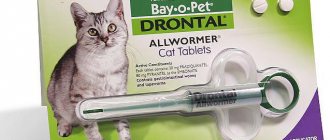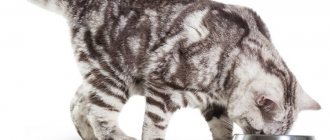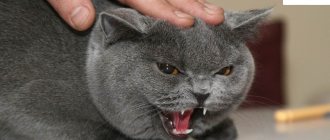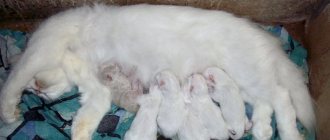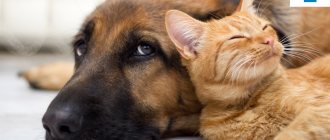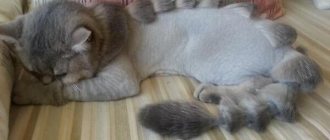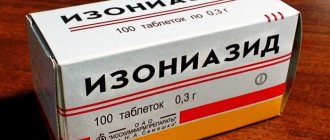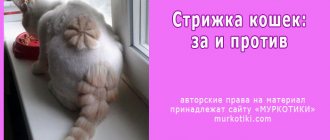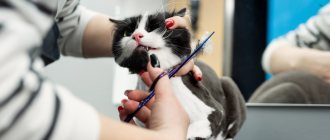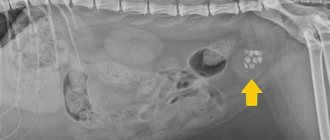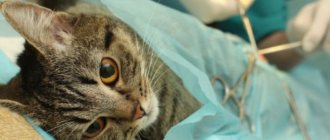If your cat has been diagnosed with urolithiasis, it means that your pet now needs special care throughout its life. It consists of constant observation and regular examination at the veterinary clinic. The diet of cats with urolithiasis is also special - it is necessary to exclude many types of foods and strictly adhere to the diet.
Features of urolithiasis
Urolithiasis is a disease in which salts form in the urinary system. They are not eliminated from the body, but accumulate. Over time, they form sand and stones that can clog the urinary ducts, causing pain and impairing organ function.
It is very important to diagnose this disease on time and provide appropriate treatment. The danger of urolithiasis is that a relapse may occur. It can be avoided only under one condition: following a diet.
When planning a diet, you need to know that with urolithiasis, stones of different origins are formed: struvite (phosphates) and oxalates.
Struvite occurs when the urine environment is alkaline, in which salts precipitate in the form of phosphorus.
Oxalates are formed in an acidic environment in which calcium levels are exceeded.
With different compositions of stones, different nutrition is used. The diet should include those foods whose consumption can neutralize the environment in the digestive system and prevent the formation of new stones.
After the tests, the doctor must tell you what type of stones your pet has and give recommendations on what you can feed your cat with urolithiasis and what not.
Failure to follow feeding rules will lead to relapse of the disease.
Causes of pathology development and methods of combating
Urolithiasis and other renal pathologies are caused by various reasons:
- improperly organized cat nutrition, excess salt in the diet;
- small quantity of water or its poor quality;
- inflammatory, systemic diseases - cystitis, urethritis and others;
- sedentary lifestyle, high-calorie foods and, as a result, obesity;
- genetic predisposition - Persian, Siamese and Russian blue cats suffer from urinary tract pathologies more often than others, which is due to the peculiarities of crossing during breeding.
In cats, the risk of developing urolithiasis is higher than in cats, since their urethral lumen is narrower. Sterilized animals are also at risk, as they are less active and quickly gain excess weight, which leads to obesity.
Therapeutic nutrition, plenty of clean water, active movement and weight control are decisive factors in the fight against urolithiasis. Cat food selected for the specific situation helps reduce the amount of insoluble sediment in the urine and, together with plenty of drinking, removes stones from the animal’s body. It is important that the pet does not overcool, otherwise inflammatory processes may develop in the genitourinary system.
Which food to choose: ready-made or natural
What kind of food to feed a cat, natural or prepared food, is chosen by each owner himself.
Ready-made medicated food has an advantage over natural food:
- all nutrients are balanced;
- vitamins are included in the food;
- the composition is selected so that the food neutralizes the environment in the stomach and urinary system.
The only downside is that special food suitable for cats with urolithiasis is sold only in pharmacies and veterinary clinics, and is not cheap.
If feeding the pet is based on natural products, the owner bears a great responsibility in their selection.
Feeding with natural food
This type of nutrition requires considerable effort and attention from the owner. Therefore, it is much easier to use ready-made food.
But if you still decide to feed your pet natural products, then the owner must adhere to the diet prescribed by the doctor in accordance with the type of stones.
When feeding natural food:
- You cannot use feed and natural food at the same time.
- It is forbidden to give only proteins.
- It is necessary to introduce porridge and vegetables into the diet.
- Be sure to monitor your cat’s gastrointestinal tract.
- Vitamins must be given.
Be sure to read:
5 signs of cystitis in cats and treatment at home
It is important to establish a sick cat’s diet and offer him enough clean water. It is necessary to ensure that the animal does not overeat.
What is important to know when using ready-made food
Medicinal food is available only in the premium class. Each package indicates that this food is intended for cats with urolithiasis. It also says what type of stones can be used for it. The composition of your pet's stones can be found out at the veterinary clinic after examination.
If the cat has not been given dry food before, it should be introduced into the diet gradually. The main task is to accustom your pet to it, because due to the specific smell and taste, many animals refuse to eat it.
Water should always be within the cat's reach. Pour only filtered water and change it twice a day. Monitor how often your cat drinks water. If he doesn’t go near a bowl of water, or drinks rarely, then you can moisten the cat food with water, but not much. There is no need to dilute it to the point of porridge.
If your pet has a good appetite, he eats the entire portion and asks for more, do not follow his lead. Excessive gluttony leads to excess weight, which is unacceptable in case of urolithiasis.
It happens that animals get bored with monotonous food. In this case, you can choose a different brand of food, or replace dry food with wet canned food. But in both cases, purchase only medicinal, premium food.
A special word should be said about feeding from the table. No matter what pitiful face your prankster makes, no matter how he rubs against your legs, there should be no concessions. If you want to treat him with something, or he deserves some encouragement, give him a piece of his food. Over time, the cat will get used to this and will accept such a treat with gratitude.
If there are no veterinary pharmacies near your home, make sure that your kitchen always has a supply of medicated food for your pet. If suddenly the food runs out, you cannot give natural food even temporarily. Keep special canned food for such cases, they have a long shelf life.
Drugs used in the treatment of ICD in cats
Dietary feed:
We prescribe special medicinal foods to the animal: Canin c/d, Feline c/d, Hill's, Whiskas pH Control Diet, Pedigree Petfoods. Hills Prescription Diet Feline S/D and Eukanuba Struvite Urinary Formula will help with struvite uroliths. These foods help dissolve stones and remove them from the body. For oxalates, Hills Prescription Diet Feline X/D, Eukanuba Oxalate Urinary Formula is prescribed. If the disease is of a mixed type, Royal Canin Urinary S/O Feline is recommended.
decoctions of woolly erva, corn silk, bearberry leaves, biseptol, urosulfan, furadonin.
Urodane and cystone should be used to dissolve and remove uroliths and sand.
"Lincomycin" or antimicrobials from the cephalosporin group ("Kefzol", "Tseparin", etc.). Continue for 5-7 days, 0.2 g twice a day. Uroseptics are antibacterial drugs that act on the genitourinary system. Cats are prescribed “5-NOK”, “Palin”, “Furagin”
cantaren
Stop cystitis Bio-suspension reduces crystallization due to its composition: lingonberry leaves, nettles, barberry, licorice root. By the way, this drug can also serve as a pain reliever. Uro-ursi A medicine that is often prescribed concomitantly with antibiotic therapy, because it contains benzoic acid, which enhances the effect of antibiotics. Urotropin The diuretic effect of "Urotropin" and its ability to increase the permeability of cell membranes accelerates the process of eliminating toxins. Cystokur forte Feed additive reduces the acidity of the body and helps the cat recover more quickly after treatment. Furinide Gel-like drops form a protective film on the bladder mucosa. Ipaquitine The components of this drug bind phosphates that the cat receives from food and reduces their availability. Cantaren Homeopathic remedy works as an anti-inflammatory, antispasmodic, and diuretic. Kotervin An aqueous extract of medicinal plants has salt-removing and stone-dissolving effects. Nephrocat Contains natural bee jelly and biologically active substances. Renal Advance The drug shows itself well in the later stages of the development of urolithiasis in cats, while it improves the functioning of the digestive system. HIMALAYA Cyston This Indian remedy copes well with cystitis and has proven to work well in combination with antibiotics. Dexamethasone This drug is often prescribed when there is persistent dysuria. Nitroxoline This synthetic agent has an antimicrobial effect. Actovegin Injections of this powerful drug activate cellular metabolism, which means metabolic processes are enhanced.
How to cook natural food
Proper nutrition based on natural products is more complex. But if you follow the rules, then it will be no worse than medicinal feed.
What should not be included in natural food:
- salt and spices;
- sausage and smoked meats;
- flour products;
- broths;
- Fish and seafood;
- dairy products;
- economy class dry food.
If these foods had been excluded from the diet when your pet was a small kitten, it is quite possible that urolithiasis could have been avoided.
If your cat has struvite (phosphates):
- not allowed - yolk, cheese, cottage cheese, dairy and fermented milk products;
- you can - boiled lean meat, cabbage, carrots, protein, rice, boiled liver, oatmeal in small quantities.
If your pet has oxalates:
- you can’t - liver, kidneys, fermented milk and dairy products, sour vegetables and fruits;
- you can - boiled lean meat, legumes, cauliflower, beets, cereals.
Even if you prefer natural food for the prevention of urolithiasis in cats, in order to avoid relapse, the doctor may prescribe medicated food for a short time. This appointment depends on what tests your pet will have after the examination. Do not forget that even if the cat is in good health, it is necessary to see a doctor and undergo tests regularly.
The portion of food should be minimal. It is better to feed more often, but little by little. Even those products that are allowed must be in limited quantities.
Due to poor nutrition, the cat needs vitamins. Talk to your veterinarian about which ones are suitable for your pet and which ones are not.
Diagnostics
- Vivid clinical signs. The cat cannot pee normally or does not pee at all.
- Palpation of the bladder. Overcrowded, with a thickened wall, sometimes it is possible to feel one or more stones.
- Urine tests. Sand in the urine, signs of inflammation - blood and leukocytes.
- X-ray, ultrasound. Detection of large stones in the kidneys and bladder.
When making a diagnosis, anamnestic data on the cat’s behavior, palpation of the bladder, clinical signs of hematuria, pain and laboratory tests of urine, urine sediment, and the presence of microflora are taken into account.
Diagnosis of urolithiasis in cats is carried out based on pronounced clinical signs. In cats, when a stone forms in the kidney or bladder, the diagnosis is confirmed by ultrasound and x-ray. During the examination, it is necessary to conduct laboratory tests of urine and ultrasound, since in some cases other diseases (tumors, inflammatory edema, cystitis) may manifest themselves in a similar way.
Diet for castrated cats
Neutered cats are more likely than others to develop urolithiasis. The fact is that after castration, the hormonal balance of animals changes. Against this background, they lose the hunter's instinct, move less, and become passive. But their appetite increases, and often they begin to eat everything indiscriminately. This cannot be allowed. Overweight cats often have health problems.
If you have a young cat that you have recently neutered, you should be more careful when compiling his menu. Before you feed a neutered cat everything and give him as much food as he asks for, think. After all, you don’t want to watch your pet suffer from pain arising from diseases of the gastrointestinal tract or urinary system.
To prevent urolithiasis in a neutered cat, follow a diet - exclude from the menu everything fatty, floury and sweet, salty and smoked. The cat's portion should be small.
Urolithiasis in many pets most often occurs due to poor diet. And the owner of the cat is to blame for this. Try to prepare him quality food.
Struvite, risk factors, treatment
Struvite uroliths form when urine becomes oversaturated with magnesium, ammonia and phosphate, and its pH rises to more than 6.5. The solubility of struvite crystals increases at urine pH below 6.5, and at a level of 6.3 struvite stops crystallizing altogether. However, the pH value of urine decreases if animals are fed a diet that promotes increased diuresis and decreased urine concentration (wet food).
Magnesium. Diets containing 0.15-1.0% magnesium (dry matter basis) were associated with the formation of struvite urinary stones in cats. However, the degree of influence of magnesium depended on the form of its compounds and on the pH of the urine.
Phosphorus. With a diet high in phosphorus (3.17-4.70 g/1000 kcal), the incidence of struvite urolithiasis in cats was almost four times higher than in animals fed a diet with a phosphorus concentration of 0.85-1 .76 g/1000 kcal. A high level of phosphorus consumption is accompanied by a more intense excretion in the urine and, as a result, induces its oversaturation with magnesium, ammonia and phosphates.
Treatment
Relief of urinary tract infections. To treat cats, it is necessary to combine dietary therapy with the use of antimicrobial drugs.
It is possible to achieve the dissolution of urinary stones formed by struvite using diet therapy. For this purpose, a diet is used that provides an increase in the volume of urine excreted and a decrease in its pH to a level of 6.3 or less. Such a diet allows you to control the animal's magnesium intake and ensures that the RSS of urine is maintained below unity (the unsaturation zone). It must contain sodium in such an amount that the animals consume more water and produce unconcentrated urine. Sterile struvite uroliths do not require additional antimicrobial therapy.
Prevention of recurrence of urolithiasis. The recurrence rate of struvite urolithiasis in cats is 2.7% with an average duration of remission of 20 months. Therefore, after dissolution or mechanical removal of uroliths, special diets are recommended for cats. This type of preventive diet should maintain urine RSS in areas of unsaturation or metastable saturation, lower urine pH to 6.5 or less, contain plenty of moisture (canned food or other wet foods), and promote increased diuresis (due to increased sodium chloride).
X-ray of the abdominal cavity, the arrow shows a large single urolith
Struvite uroliths from the bladder
Struvite uroliths of various types
Calcium oxalate
The average age at which most cats are diagnosed with urolithiasis is 7.8 years (but it can occur in animals between 2 and 18 years of age). The risk of calcium oxalate uroliths increases in older animals.
Most often, this type of urolithiasis affects males (55%) - in females, calcium oxalate urinary stones are found approximately 1.5 times less often.
Burmese, Himalayan and Persian cats have a predisposition to the formation of calcium oxalate uroliths, which suggests the existence of genetic factors that contribute to the development of this type of urolithiasis. Keeping cats exclusively indoors is an additional risk factor for the development of calcium oxalate urolithiasis.
Calcium oxalate uroliths
Effect of metabolic acidosis on urinary calcium excretion
Under conditions of metabolic acidosis, the release of calcium phosphate and carbonate from bone tissue is stimulated, which enter the blood, where they perform buffering functions. Excess calcium is excreted in the urine, which increases the risk of calcium oxalate uroliths.
Treatment and prevention of relapses
Calcium oxalate uroliths are not amenable to drug treatment. Therefore, urinary stones found in the bladder must be removed mechanically - by washing them out of the urinary tract with water under high pressure or surgically.
You should avoid dry foods that are not intended to reduce urine pH, as well as medications that increase the excretion of calcium from the body in the urine (urine acidifiers, furosemide, and others). Such cats should not be given treats or food additives containing calcium, vitamin D or vitamin C in increased quantities, as they increase the excretion of calcium and oxalates in the urine.
Formulate your cat's diet to maintain a urine pH of 5.8-6.2, thereby ensuring a low (below 5) RSS of urine calcium oxalate. It is necessary to ensure that cats consume more water - this is the main factor in the treatment and prevention of calcium oxalate urolithiasis.
Treatment approaches for localization of urinary stones in the kidneys and ureters
Removing urinary stones from the kidneys surgically (nephrectomy) entails the inevitable loss of nephrons. Therefore, this method of treatment is not recommended until it becomes clear that the uroliths located in the kidney are indeed causing serious illness in the animal. The indication for dissection of the ureter in order to remove uroliths from it is the progressive development of hydrocele of the renal pelvis. The operation is performed only if there is indisputable evidence that urinary stones are localized in the ureter. After such surgery, cats may experience complications such as urine accumulation in the abdominal cavity and ureteral stricture. An alternative to surgical treatment is conservative therapy.
Urate uroliths
These uroliths consist of uric acid and the monobasic ammonium salt of uric acid (ammonium urate). Urates are found less frequently (<6%) than struvite and calcium oxalate.
Formed in animals with portosystemic anastomosis and in various forms of severe liver dysfunction, they usually contain struvite.
Urate urinary stones
Urate uroliths occur:
- for urinary tract infections accompanied by an increase in the concentration of ammonia in the urine;
- with metabolic acidosis and highly alkaline urine;
- when receiving a diet rich in purines (made from liver or other internal organs).
Xanthine uroliths
They are rare. The formation is associated with a congenital disorder of purine metabolism, or they are formed as a result of cats receiving allopurinol orally.
Diet therapy strategy: reducing the purine content in the diet, high water consumption, giving wet food.
Treatment of uric acid with allopurinol should be stopped immediately - the drug promotes the formation of xanthine uroliths.
Xanthine urinary stones
Calcium phosphate uroliths
The cat is examined for the presence of high concentrations of calcium and/or phosphate in the urine, hypercalcemia, primary parathyroidism, and alkaline urine (pH > 7.5). If the patient’s primary disease could not be diagnosed, against the background of which calcium phosphate urolithiasis developed, then they resort to a treatment strategy similar to calcium oxalate urolithiasis. However, the necessary precautions should be taken to prevent an excessive increase in urine pH, which often happens when a cat receives special food intended for the treatment of calcium oxalate urolithiasis.
Cystine uroliths
Cystine uroliths are formed in cats with cystinuria, which occurs as a congenital disorder of the reabsorption of cystine and other amino acids (ornithine, lysine, arginine) in the proximal tubules of the kidneys. In most cases, cystine uroliths are found in aging cats.
Small cystine uroliths can be removed from the urinary tract by flushing it with high pressure water. Large urinary stones must be removed surgically (through cystotomy).
Electron microscopy image of cystine urolith
Reduce the content of methionine and cystine in the diet while using drugs containing thiol.
Alkalinization of urine. The solubility of cystine depends on the pH environment; it increases in alkaline urine. You can increase the pH of urine by using a diet containing potassium citrate or by giving animals this drug orally.
Features of dietary nutrition
A new diet is selected by a veterinarian. Lists of permitted and prohibited products are compiled taking into account the age of the animal, the severity of the clinical case, the presence of relapses and the type of stones formed.
Meals are strictly fractional. Meals should be taken 4 to 5 times a day, portions should be small. The main thing is to prevent your pet from overeating. If the cat does not have the habit of begging for food, you can feed it once. When your pet constantly asks for food, leaving food freely available is not recommended.
An important aspect in dietary nutrition is proper drinking regimen. It is forbidden to give water from the tap. The liquid must be boiled or filtered so that it contains a minimum amount of chlorine and other chemical impurities that, settling on the walls of the kidneys, can cause stone formation. Proper drinking regimen is especially important for cats that eat only dry food.
